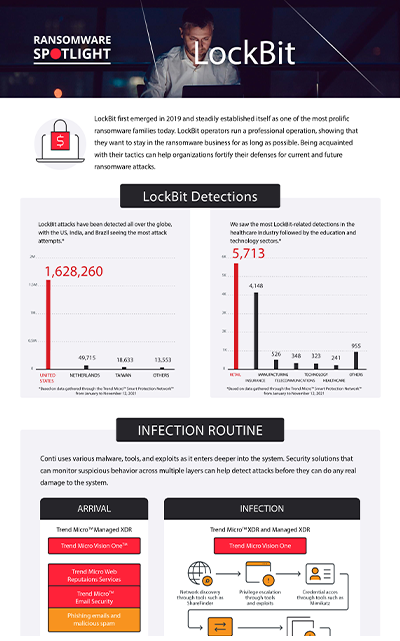Ransom.Win32.LOCKBIT.SMCET
Ransom:Win32/Lockbit.SA!MSR (MICROSOFT)
Windows


Threat Type: Ransomware
Destructiveness: No
Encrypted:
In the wild: Yes
OVERVIEW
This Ransomware arrives on a system as a file dropped by other malware or as a file downloaded unknowingly by users when visiting malicious sites.
It executes then deletes itself afterward.
It drops files as ransom note.
TECHNICAL DETAILS
Arrival Details
This Ransomware arrives on a system as a file dropped by other malware or as a file downloaded unknowingly by users when visiting malicious sites.
Installation
This Ransomware drops the following files:
- %User Temp%\63C3.tmp.bmp
(Note: %User Temp% is the current user's Temp folder, which is usually C:\Documents and Settings\{user name}\Local Settings\Temp on Windows 2000(32-bit), XP, and Server 2003(32-bit), or C:\Users\{user name}\AppData\Local\Temp on Windows Vista, 7, 8, 8.1, 2008(64-bit), 2012(64-bit) and 10(64-bit).)
It adds the following processes:
- "%System%\cmd.exe" /c vssadmin delete shadows /all /quiet & wmic shadowcopy delete & bcdedit /set {default} bootstatuspolicy ignoreallfailures & bcdedit /set {default} recoveryenabled no & wbadmin delete catalog -quiet
- "%System%\mshta.exe" "%Desktop%\LockBit-note.hta"
- "%System%\cmd.exe" /C ping 127.0.0.7 -n 3 > Nul & fsutil file setZeroData offset=0 length=524288 "{Malware full path}" & Del /f /q "{Malware full path}"
(Note: %System% is the Windows system folder, where it usually is C:\Windows\System32 on all Windows operating system versions.. %Desktop% is the current user's desktop, which is usually C:\Documents and Settings\{User Name}\Desktop on Windows 2000(32-bit), XP, and Server 2003(32-bit), or C:\Users\{user name}\Desktop on Windows Vista, 7, 8, 8.1, 2008(64-bit), 2012(64-bit) and 10(64-bit).)
It executes then deletes itself afterward.
Autostart Technique
This Ransomware adds the following registry entries to enable its automatic execution at every system startup:
HKEY_CURRENT_USER\Software\Microsoft\
Windows\CurrentVersion\Run
XO1XADpO01 = {Malware full path}
Other System Modifications
This Ransomware adds the following registry entries:
HKEY_CURRENT_USER\Software\LockBit
full = {hex values}
HKEY_CURRENT_USER\Software\LockBit
Public = {hex values}
HKEY_LOCAL_MACHINE\SOFTWARE\Microsoft\
Windows\CurrentVersion\Run
{2C5F9FCC-F266-43F6-BFD7-838DAE269E11} = %Desktop%\LockBit-note.hta
It changes the desktop wallpaper by modifying the following registry entries:
HKEY_CURRENT_USER\Control Panel\Desktop
Wallpaper = %User Temp%\63C3.tmp.bmp
Other Details
This Ransomware adds the following registry keys:
HKEY_CURRENT_USER\Software\LockBit
Ransomware Routine
This Ransomware appends the following extension to the file name of the encrypted files:
- .lockbit
It drops the following file(s) as ransom note:
- {Encrypted folder}\Restore-My-Files.txt
- %Desktop%\LockBit-note.hta
(Note: %Desktop% is the current user's desktop, which is usually C:\Documents and Settings\{User Name}\Desktop on Windows 2000(32-bit), XP, and Server 2003(32-bit), or C:\Users\{user name}\Desktop on Windows Vista, 7, 8, 8.1, 2008(64-bit), 2012(64-bit) and 10(64-bit).)
SOLUTION
Step 1
Trend Micro Predictive Machine Learning detects and blocks malware at the first sign of its existence, before it executes on your system. When enabled, your Trend Micro product detects this malware under the following machine learning name:
- Troj.Win32.TRX.XXPE50FFF041
Step 2
Before doing any scans, Windows 7, Windows 8, Windows 8.1, and Windows 10 users must disable System Restore to allow full scanning of their computers.
Step 3
Note that not all files, folders, and registry keys and entries are installed on your computer during this malware's/spyware's/grayware's execution. This may be due to incomplete installation or other operating system conditions. If you do not find the same files/folders/registry information, please proceed to the next step.
Step 4
Delete this registry key
Important: Editing the Windows Registry incorrectly can lead to irreversible system malfunction. Please do this step only if you know how or you can ask assistance from your system administrator. Else, check this Microsoft article first before modifying your computer's registry.
- In HKEY_CURRENT_USER\Software\LockBit
- = ""
- = ""
Step 5
Delete this registry value
Important: Editing the Windows Registry incorrectly can lead to irreversible system malfunction. Please do this step only if you know how or you can ask assistance from your system administrator. Else, check this Microsoft article first before modifying your computer's registry.
- In HKEY_CURRENT_USER\Software\LockBit
- full = {hex values}
- full = {hex values}
- In HKEY_CURRENT_USER\Software\LockBit
- Public = {hex values}
- Public = {hex values}
- In HKEY_LOCAL_MACHINE\SOFTWARE\Microsoft\Windows\CurrentVersion\Run
- {2C5F9FCC-F266-43F6-BFD7-838DAE269E11} = %Desktop%\LockBit-note.hta
- {2C5F9FCC-F266-43F6-BFD7-838DAE269E11} = %Desktop%\LockBit-note.hta
Step 6
Search and delete these files
- {Encrypted folder}\Restore-My-Files.txt
- %Desktop%\LockBit-note.hta
- %User Temp%\63C3.tmp.bmp
Step 7
Scan your computer with your Trend Micro product to delete files detected as Ransom.Win32.LOCKBIT.SMCET. If the detected files have already been cleaned, deleted, or quarantined by your Trend Micro product, no further step is required. You may opt to simply delete the quarantined files. Please check the following Trend Micro Support pages for more information:
Step 8
Enabling Volume Shadow Service
- Run the command prompt (cmd.exe) as administrator.
- Enable Volume Shadow Service by typing the following command:
net start vss
Step 9
Restore encrypted files from backup.
Step 10
Reset your Desktop properties
Did this description help? Tell us how we did.


